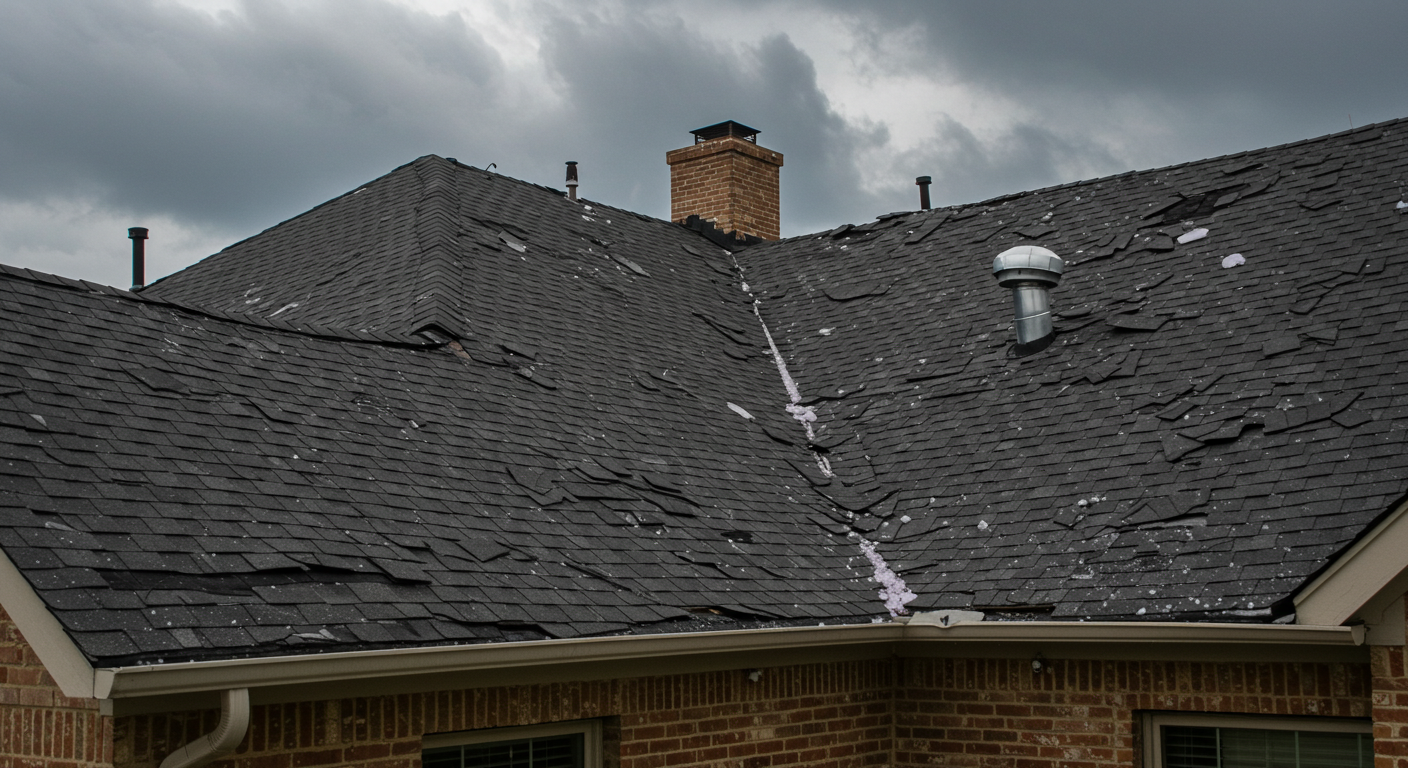6 Ways to Spot Wind Damage to Your Roof After a Storm













High winds can wreak havoc on any roof. Gusts as low as 45–50 mph can lift shingles, while stronger winds over 70 mph can damage heavier materials like tile and slate. Knowing what to look for helps you act fast and protect your home.
Below are common signs of wind damage for each roofing type:
Traditional Asphalt Shingle Roofs
Most homes here in the Dallas area are made of asphalt shingles. Wind can damage asphalt shingles by getting under the edges and lifting them up, sometimes blowing the shingle away entirely.
Signs of damage can include:
- Missing or torn shingles
- Lifting or curling edges
- Creased shingles: line across the shingle where the material has folded up due to wind, like the crease line that forms when you fold a piece of paper)
- Granule loss: asphalt shingles are covered with gritty granules that protect them from UV light. Bald spots or a gritty substance collecting in gutters can be signs of damage
Tile Roofs
Clay and concrete tile roofs are another popular roofing style in our area. Tile roofs are less likely to blow away than shingles, but are susceptible to impact damage from flying debris.
Damage may look like:
- Broken, cracked, or missing tiles (often visible from the ground)
- Tiles that are dislodged or sliding out of place
- Chipped corners or impact marks from being hit with debris
Metal Roofs
Metal roofs usually last longer than shingles and are strong, but can come with their own set of issues.
After a storm, look for:
- Loose or lifted panels
- Bent, warped, or misaligned seams
- Missing fasteners or screws
- Dents from debris impacts
Designer Shingle Roofs
Some homeowners may opt for high-end designer shingles with patterned designs. Designer shingles may also mimic the appearance of other materials like slate.
If designer shingles are damaged, you may see:
- Sections where staggered patterns no longer align
- Torn or lifted shingles
- Uneven surfaces that look “bumpy” compared to surrounding areas
Slate Roofs
Roofs made of heavy slate rock are very durable and can create a classic or historical feel.
If a slate roof sustains damage from a windstorm, it often looks like one of the following:
- Missing or slipping slate pieces
- Cracks running across tiles
- Small piles of broken slate fragments near gutters
Synthetic Roofs
Synthetic roofs are a newer option with high curb appeal. They are designed to look like natural slate or cedar shakes but are actually made of materials like recycled plastic, rubber, or synthetic polymers.
Damage may appear as:
- Sections that appear warped or lifted
- Cracked or punctured material
- Gaps between panels
- Uneven edges
What to Do if You Suspect Wind Damage
Step 1: Walk around your property.
- Check for obvious damage from the ground.
- Look for debris piles, broken tiles, or missing shingles.
Step 2: Inspect the attic and ceilings.
- Look for water stains, damp insulation, or active drips.
- Check around vents and chimneys for gaps or water entry.
Step 3: Document everything.
- Take photos of damage from multiple angles.
- Take detailed notes about the date, wind speeds (if available), and the specific signs of damage you find.
Step 4: Call a reputable roofer.
- Request a professional inspection to identify hidden issues.
- A qualified contractor can help you understand repair vs. replacement options and help you make a plan that is right for you.
Step 5: File an insurance claim.
- Your homeowners insurance will likely cover some or all of the costs of fixing your roof after damage from a windstorm. Make sure you file a claim and provide photo evidence of the damage.
- A good roofer will walk you through the insurance process step by step and help you work with the insurance company to get the appropriate settlement. Ask for their help!
Step 6: Schedule repairs promptly.
- Wind damage often gets worse over time, especially when rain follows.
- Quick action can prevent leaks, mold, and structural problems.
Final Thoughts
Severe weather can strike at any time. By knowing how wind damage shows up on different types of roofs and what to do if you find it, you will be well equipped to protect your home, save on repairs, and keep your roof strong for years to come.
Need help? Connect with a trusted local roofing professional after the next big storm to schedule an inspection and get peace of mind knowing that your roof is safe.








